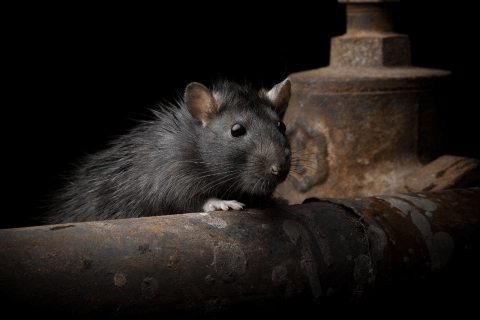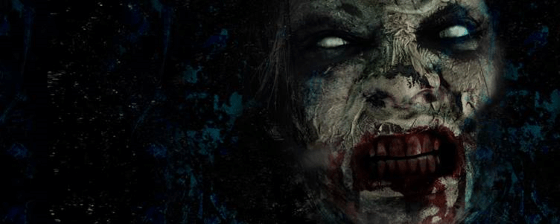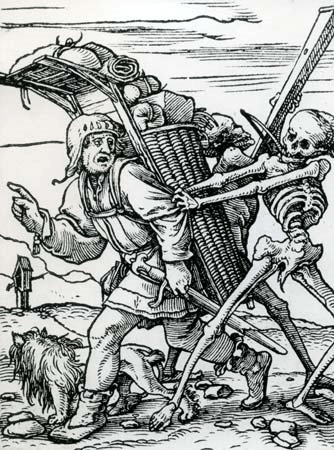
THE DEAD TIMES
DEAD ARE COMING...
Zombie Crier - The Black Death
Shortly before Christmas 2018, a documentary was aired on TV discussing and investigating the chilling terror called, in all Hollywood-majesty, 'The Black Death'. 'The Black Death' was a vile, almost cataclysmic, plague that swept across Europe, first entering the UK in the summer of 1348 and swiftly spreading throughout all of Britain, reaching the highest peaks of Scotland two years later. It was a foul sickness that had a range of grotesque symptoms including the formation of unspeakable pus-filled boils and tumours on the body, unstoppable bleeding, vomiting and debilitating weakness. It is estimated that 100 to 200 million people died from this merciless killer as it continued to ravage the land throughout the 14th century.
So why am I telling you all this and what does it have to do with Zombies or the Zombie Crier series? The widely accepted answer of 'The Black Death' being bubonic plague spread by rats is so often spouted, it seems irrefutable. Indeed, it would appear that the official 'case-closed' stamp has been firmly smacked on this gruesome tale and any argument to the contrary could be seen as folly. Recent events though have called this alleged "truth" into question and where a new rabbit hole has opened up, you can guarantee I'll be there, digging away at a tangent to the others, looking, hoping, to find signs of the macabre - to find signs, whispers, fragments of speculation pointing towards one thing and one thing only, the living dead. At the start, as with any journey into the unknown with only a theory that, would be seen to many as a light jest (I mean, Zombies, in medieval England, really?), I was unsure of my chances of success. However, the more I explored this diabolical idea, the more I delved into the warren-like rabbit hole I was expanding, the more persuaded - and worried - I became.
It was not bubonic plague
So lets start off with a biggie - 'The Black Death' was not bubonic plague.
"Although on the surface, [it would] seem to have been similar, we are not convinced that the epidemic in the 14th century and the present day bubonic plague are the same,"
- Dr. James Wood, professor of anthropology and demography at Penn State.
Basically, many of the reported symptoms from the time, just did not fit the bubonic plague handbook - yes, there were overlaps, but this is also true for a host of other diseases. Granted, symptom documentation coming from a time when the medical profession had not really taken off was sketchy at best, especially considering many reports were made by unskilled, poorly-educated, regular city-dwellers, but it does at least peal back the lid on the sealed coffin of this illness a tad. In addition, the death-rate of the plague was often as high as 45% - a bit beyond what is considered typical for bubonic plague.
The other major pointer to 'The Black Death' being bubonic plague was that it was, as is widely accepted, spread by wild rodents; namely, rats.
"This disease appears to spread too rapidly among humans to be something that must first be established in wild rodent populations, like bubonic plague."
What's more, if the plague did originate and get spread by rats, it would, typically for this sort of infection, first have had to build up to a significantly high frequency in wild populations before spilling over into the human community via the humble rat flea. Naturally then, you would expect to see large numbers of dead rats around.
"There are no reports of dead rats in the streets in the 1300s of the sort common in more recent epidemics when we know bubonic plague was the causative agent,"
Also, remember that this all happened in the 14th century and occurred right across Britain. At the time Britain was not nearly as densely inhabited as it is today - so, in order to spread successfully, the plague would have had to cross large rural areas where not that many people were living. Now, I don't know much about rat lifestyle or territory range but people getting infected over large areas of countryside from singular rats with the rapidity showed by 'The Black Death' is an unlikely prospect.
So, if not bubonic plague, then what was it?
That's the very, very expensive question (and, as it happens, my stepping off point). The answer is that no one really knows for sure and probably will never know with 100% certainty. Some of the symptoms point to a strain of Ebola, some scientists think it was still bubonic plague, just an early form with different effects caused by random mutation, most don't want to even speculate in case its mere identification brings it back in a hideously advanced form. Me? You can probably guess what I think. I think it was an early form of the Zombie virus.
The Zombie virus. You are joking right?
No, I am deathly serious. It my be nothing more than idle fantasy but hear me out on this as I have some (speculative) evidence to back up my zany claim.
How it was spread
So, I've already shown how the rat theory just does not hold up. Something mentioned in the documentary I watched stuck with me; it said the plague spread very quickly and often jumped between towns, individual family members catching the infection from already stricken family members and so on, almost as if it was spread by eye; an afflicted person simply looking at someone was all it took to spread the disease. Obviously, this is not true (I hope) but it got me thinking. When people come in close proximity to infected people, they are much more likely to themselves get infected, return home as the effects aren't instantaneous and proceed to infect other people in that town whereby the cycle begins anew. Sound familiar? Yep, that's right; it's just how you would expect a Zombie virus to spread. The numbers add up; first you have one person sick, in bed, desperate for help but unable to find any. Their single family member turns up to comfort them as they lie, not long for this world. The sick person, after losing control to the microscopic agent of chaos inside them, bites the healthy comforter and now you have two infected. They both bite one other person, leaving four shuffling ghouls. Then eight, then sixteen, then thirty-two and on and on - expanding among the populace with brutal rapidity, jumping from town to town as those infected by distant family members return home, unwitting carriers of the undying plague.
It spread like wildfire - we know this. That's no proof that the dead got up and started eating people.
No, no - only a fool would think such a thing but now my radical theory had a base, I could start building upwards. Again, I got my brain-cogs whirring and I recalled that, during my research I spied an awful lot of pictures that came out of the period, obviously not photographs but paintings and sketches. Of these, a disturbing number showed skeletons or demons - personifications of evil or death - Hellish beings dancing around, interacting with or torturing the living. In fact, some pictures even showed very thin people, their skin hanging loose off their bones, taking the healthy away, inflicting the uninfected soul with the unstoppable disease. To me, all these paintings are suggesting one thing; death coming alive and killing people. I'll repeat that, just to heighten its dramatic power, death coming alive and killing people.
However, these are clearly not paintings of actual dead people - they are not the true horror of soulless, waving, animated sacks of meat that we associate with Zombies today; why not paint the lurid truth if it was actual Zombies? Well, you've got to take into account that, back then, no one knew what a Zombie was or had even heard of the term. Tales of the undead go back millennia (look at the TED talk for proof of that) though these are usually Vampires, Gargoyles and other winged demons - biblical creatures from Hell. To a non-living-dead-educated mind, when presented with the unknown, you fall back on what you do know and extrapolate forward - it's a very natural thing. So, upon seeing a figure that should be dead act as if it was not dead; it must be a demon or some other creature from the night disguised as a man - the paintings could have been real, they could have shown the truth, just a different perspective of the truth.
There's also the lesser point that the artists who made these paintings needed to eat, to live, to survive - they needed their paintings to make money. If you have a detailed painting of a rotting corpse partially devouring a fallen, defenceless man, with all the gore and blood that entails, the potential marketing audience for that painting is going to be significantly reduced.
I still think you're clutching at straws; where is the proof?
I cannot lie, there is no proof - no cold, hard concrete fact that can back up my unrighteous claims. With that laid bare, I would remind you that the "absence of evidence is not evidence of absence" - just because there is no evidence of the dead living again, does not mean it did not happen. You'll assume it did not happen, drawing from the facts of today, where Zombies do not exist (at least, scientifically), but "past experience can never prove the future".
Besides, what evidence would there be? I have already written a lengthy article about why we can never find evidence of Zombies; anything that was found would simply point back to the living humans they were and not the grotesque monstrosities they became. Failing physical substantiation, you may have expected someone from the time to document Zombie-like activities from plague sufferers but again, you'd be thwarted. Erratic, uncoordinated and aggressive behaviour would have likely just been shrugged off as a symptom of the disease that no one really understood. Additionally, anti-social acts and mental illnesses were undoubtedly rife in those times before political correctness, manners or well-being even became things central to society. If a plague-stricken individual did try to bite a living person, the patient would probably just be considered insane or delirious, potentially causing them to be whisked off to a mental asylum, spreading the undying disease even more.
Ok - I'll give it to you - you may be onto something, but why should I care?
I'm glad you asked that particular question: For a start, you should obviously care because I am telling you and that it is a potential site of that which we all hold dear: Zombies. Matters of pride aside, there is a much more sinister, daunting, and - dare I say it - terrifying additional reasoning behind my telling of this tale. You see, 'The Black Death' - that monster and killer of so many - it isn't, well - how, should I put this - it's not dead yet.
Actually, plague has been going on for quite some time; 'The Black Death' only being one, particularly deadly outbreak. The last recorded major outbreak was in China in the 1890s and still today, even with our modern treatments, people still die from plague. Of course, these modern plagues are not actually causing Zombie outbreaks (that we know of) - perhaps 'The Black Death' had some rare mutated gene that caused the dead to rise. Recently, scientists in Sweden found a frozen human corpse from 5,000 years ago that contained the earliest known form of plague. It just goes to show, once a disease is found, once nature concocts a particular serum, it will never truly go away, instead lying dormant, waiting silently, changing itself, altering some vital thing about its structure, waiting for that opportune moment, the ideal conditions, the time to strike.
DESCRIPTION:
In the long-awaited return of the Zombie Crier series, I investigate a devilish time from history infamous for 'The Black Death'. This infernal plague needs no introduction but did you know that much of what is commonly believed is false? This provides the perfect opportunity to interject the question; "Was it Zombies?". The answer, is shocking.
CATEGORY:
Zombie Crier
WRITTEN BY:
DATE UPLOADED:
17/02/2019




